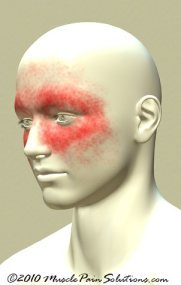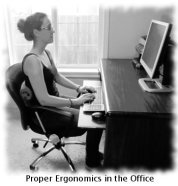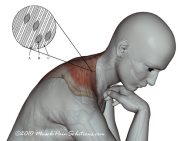Chronic Sinus Headaches —
Are they really from your sinuses?

You may be surprised to learn that your chronic sinus headaches may not be coming from your sinuses but may actually be the result of pain referral from muscles in your head and neck creating sinus pain. Some of these muscles can even create nasal congestion, or a runny nose.
I had a patient with this problem... he had been having chronic "sinus" headaches above and below his left eye for over 10 years when he came to see me for a back problem. In passing, he mentioned his headaches, which had been evaluated with MRI and CT scans without result. He had also had cryotherapy were certain parts inside the nose are frozen, and had even had exploratory surgery of his sinuses! All these interventions had failed to help relieve his headaches which he lived with daily. When I suggested that the headaches could be coming from his sternocleidomastoid muscle, he was skeptical, but willing to try anything. In about 2 months, he was down to an occasional mild headache that he could relive with proper hydration and self massage.
Symptoms of chronic sinus headaches
So how can you tell where your chronic sinus headaches are coming from? The pain will usually be in the cheek bones, forehead, and bridge of the nose, and may increase with sudden head movements. These symptoms can be the same whether the origin of the pain is from the sinuses or the trigger points. Other symptoms such as nasal discharge and ear fullness are more likely to be from the sinuses but can be imitated by the sternocleidomastoid muscle. If fever, facial swelling, or other signs of illness are present, or if the nasal discharge is dark yellow or green, then it is much more likely to be coming from the sinuses. If this is the case, I recommend trying nasal irrigation, where you clean out the sinuses several times per day. I have found this to be very effective way to get rid of sinus infections.
What if trigger points are causing your chronic "sinus headaches"?
Use this chart is a quick reminder for easy treatment of trigger points. For more complete info, check out the self massage page, or check out the page on trigger point treatment.
Self Massage: Trigger Point Pressure Release |
|
The following muscles are listed in the order of most likely to least likely to create chronic "sinus" headaches.
Sternocleidomastoid (SCM) — This is a very interesting muscle that can create a whole spectrum of problems, from dizziness and nausea, to ear ringing and head pain. The muscle has two branches - the sternal branch that runs from the skull behind the ear to the breast bone, and the clavicular branch that runs from the same place behind the ear underneath the sternal division to the collar bone. The sternal division can create the pain on the cheek bones, behind and above the eyes, and the clavicular division can create the pain in the forehead, and together it can feel like a sinus pressure headache. The trigger points are located along the whole length of the muscle. For more complete info on this muscle, click here.
Masseter muscle — This muscle is the main chewing muscle, and starts right under your cheek bone, and ends covering the angle of your jaw. It is the one you will feel pop out right in front of your ear when you clench your jaw. It is irritated by clenching your jaw, chewing gum, ice, and nails, as well as dental work. In addition to creating pain above the eyes, it also creates jaw pain, facial pain, tooth pain and sensitivity to heat and cold. It can also act like a sinus problem with sinus pain and drainage and stuffiness. It can also create deep ear pain, itch, or even a low roar in the ears. To treat these muscles, put your thumb inside your mouth outside your teeth and fingers outside and pinch. If you need it, it will hurt like crazy, but be patient and persistent with this and you will get relief from your symptoms. Click here for a picture.
Lateral Pterygoid — This muscle is largely responsible for TMJ (temporomadibular joint) problems and pain, but it also refers pain over the cheek bones, and can imitate sinusitis, and even stimulate sinus secretions. It can also create popping or clicking, and pull the jaw forward. In some people, this muscle can create tinnitus. Trigger points are created and perpetuated in this muscle similarly to the masseter. To massage this muscle, reach your index finger inside your mouth but outside your teeth as far back and high as it will reach. You will find a deep pocket there. Push upward and inward to work on the muscle. If you need it, this area can be excruciating. Work slowly and gently, but persistently to eliminate trigger points in this muscle. Click here for a picture.
Obicularis oculi — This is an odd muscle that makes a ring around your eye, and helps you close your eye and squint. Trigger points are usually created by tension and eye strain, or poor eye sight. In addition to creating eye pain, trigger points in this muscle can make your eye eyelid droop, your eye twitch, and even the print to "jump" on the page. You can gently push on this muscle, but usually these trigger points are secondary to the SCM (see above). Click here for a picture.
Zygomaticus Major and Levator Labii — These muscles start at the cheek bone and lower rim of the eye socket and run to the upper lip. They create "sinus" pain, and pain up the nose into the forehead. They can even create allergy symptoms like a runny nose, sneezing, and itchy eyes. To massage them, just grab your cheek below your eye and kneed any painful spots. Click here for a picture.
To learn more about nasal irrigation for true chronic sinus headaches, click here.
Return from Chronic Sinus Headaches to What Causes Headaches Headache page.




